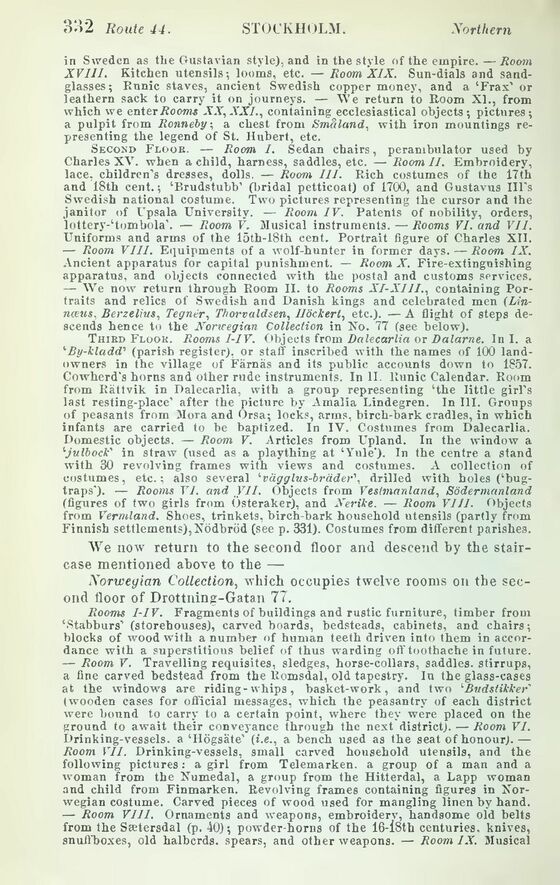
Full resolution (JPEG) - On this page / på denna sida - Sweden - Pages ...

<< prev. page << föreg. sida << >> nästa sida >> next page >>
Below is the raw OCR text
from the above scanned image.
Do you see an error? Proofread the page now!
Här nedan syns maskintolkade texten från faksimilbilden ovan.
Ser du något fel? Korrekturläs sidan nu!
This page has never been proofread. / Denna sida har aldrig korrekturlästs.
in Sweden as the Gustavian style), and in the style of the empire. — Room
XVIII. Kitchen utensils-, looms, etc. — Room XIX. Sun-dials and
sandglasses; Runic staves, ancient Swedish copper money, and a ‘Frax’ or
leathern sack to carry it on journeys. — We return to Room XI., from
which we enter Rooms XX, XXI., containing ecclesiastical objects; pictures;
a pulpit from Ronneby; a chest from Småland, with iron mountings
representing the legend of St. Hubert, etc.
Second Flooe. — Room I. Sedan chairs, perambulator used by
Charles XV. when a child, harness, saddles, etc. — Room II. Embroidery,
lace, children’s dresses, dolls. — Room III. Rich costumes of the 17th
and 18th cent.; ‘Brudstubb’ (bridal petticoat) of 1700, and Gustavus Ill’s
Swedish national costume. Two pictures representing the cursor and the
janitor of Upsala University. — Room IV. Patents of nobility, orders,
lottery-Hombola’. — Room V. Musical instruments. — Rooms VI. and VII.
Uniforms and arms of the 15th-18th cent. Portrait figure of Charles XII.
— Room VIII. Equipments of a wolf-hunter in former days. — Room IX.
Ancient apparatus for capital punishment. — Room X. Fire-extinguishing
apparatus, and objects connected with the postal and customs services.
— We now return through Room II. to Rooms XI-XIII., containing
Portraits and relics of Swedish and Danish kings and celebrated men
(Linnaeus, Berzelius, Tegnér, Thorvaldsen, Ilöckerl, etc.). —A flight of steps
descends hence to the Norwegian Collection in No. 77 (see below).
Third Floor. Rooms I-IV. Objects from Dalecarlia or Dalarne. Ini. a
’By-kladd’ (parish register), or staff inscribed with the names of 100
landowners in the village of Färnäs and its public accounts down to 1857.
Cowherd’s horns and other rude instruments. In II. Runic Calendar. Room
from Rättvik in Dalecarlia. with a group representing ‘the little girl’s
last resting-place’ after the picture by Amalia Lindegren. In III. Groups
of peasants from Mora and Orsa; locks, arms, birch-bark cradles, in which
infants are carried to be baptized. In IV. Costumes from Dalecarlia.
Domestic objects. — Room V. Articles from Upland. In the window a
1julbock’ in straw (used as a plaything at ‘Yule’). In the centre a stand
with 30 revolving frames with views and costumes. A collection of
costumes, etc.; also several ’vägglus-bräder’, drilled with holes
(‘bug-traps’). — Rooms VI. and VII. Objects from Vestmanland, Södermanland
(figures of two girls from Österåker), and Xerike. — Room VIII. Objects
from Vermland. Shoes, trinkets, birch-bark household utensils (partly from
Finnish settlements),Nödbröd (see p. 331). Costumes from different parishes.
We now return to the second floor and descend by the
staircase mentioned above to the —
Norwegian Collection, which occupies twelve rooms on the
second floor of Drottning-Gatan 77.
Rooms I-IV. Fragments of buildings and rustic furniture, timber from
‘Stabburs’ (storehouses), carved boards, bedsteads, cabinets, and chairs;
blocks of wood with a number of human teeth driven into them in
accordance with a superstitious belief of thus warding off toothache in future.
— Room V. Travelling requisites, sledges, horse-collars, saddles, stirrups,
a fine carved bedstead from the Romsdal, old tapestry. In the glass-cases
at the windows are riding-whips, basket-work, and two ‘Budstikker’
(wooden cases for official messages, which the peasantry of each district
were bound to carry to a certain point, where they were placed on the
ground to await their conveyance through the next district). — Room VI.
Drinking-vessels, a ‘Högsäte’ (i.e., a bench used as the seat of honour). —
Room VII. Drinking-vessels, small carved household utensils, and the
following pictures: a girl from Telemarken, a group of a man and a
woman from the Numedal, a group from the Hitterdal, a Lapp woman
and child from Finmarken. Revolving frames containing figures in
Norwegian costume. Carved pieces of wood used for mangling linen by hand.
— Room VIII. Ornaments and weapons, embroiderv, handsome old belts
from the Sætersdal (p. 40); powder-horns of the 16-l8th centuries, knives,
snuffboxes, old halberds, spears, and other weapons. — Room IX. Musical
<< prev. page << föreg. sida << >> nästa sida >> next page >>